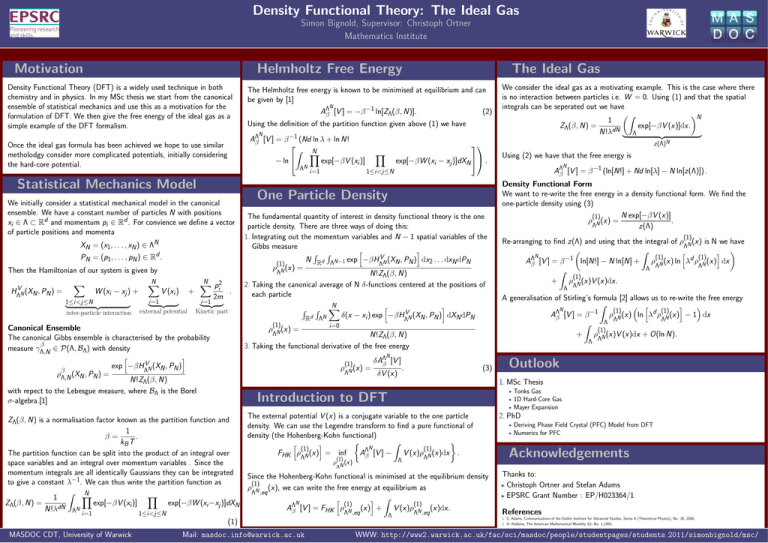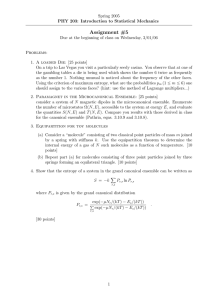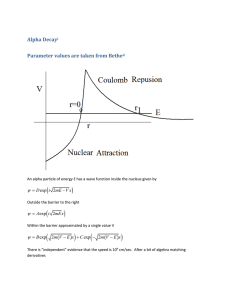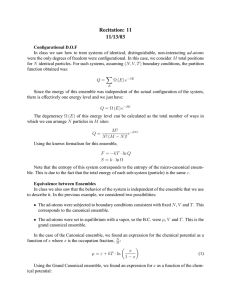Density Functional Theory: The Ideal Gas Motivation M A S
advertisement

Density Functional Theory: The Ideal Gas
M A S
D O C
Simon Bignold, Supervisor: Christoph Ortner
Mathematics Institute
Helmholtz Free Energy
Motivation
Density Functional Theory (DFT) is a widely used technique in both
chemistry and in physics. In my MSc thesis we start from the canonical
ensemble of statistical mechanics and use this as a motivation for the
formulation of DFT. We then give the free energy of the ideal gas as a
simple example of the DFT formalism.
We initially consider a statistical mechanical model in the canonical
ensemble. We have a constant number of particles N with positions
xi ∈ Λ ⊂ Rd and momentum pi ∈ Rd . For convience we define a vector
of particle positions and momenta
XN = (x1, . . . , xN ) ∈ ΛN
PN = (p1, . . . , pN ) ∈ Rd .
Then the Hamiltonian of our system is given by
HΛVN (XN , PN ) =
X
W (xi − xj ) +
1≤i<j≤N
|
{z
}
inter-particle interaction
N
X
V (xi )
|i=1 {z }
external potential
pi2
.
+
2m
|i=1{z }
Kinetic part
ΛN i=1
exp[−βV (xi )]
Y
exp[−βW (xi − xj )]dXN .
z(Λ)N
Using (2) we have that the free energy is
N
Λ
Aβ [V ] = β −1 (ln[N!] + Nd ln[λ] − N ln[z(Λ)]) .
1≤i<j≤N
The fundamental quantity of interest in density functional theory is the one
particle density. There are three ways of doing this:
1. Integrating out the momentum variables and N − 1 spatial variables of the
Gibbs measure
i
h
R R
V (X , P ) dx . . . dx dP
N
exp
−βH
d
N−1
2
N N
R Λ
(1)
ΛN N N
ρ N (x) =
Λ
N!ZΛ(β, N)
2. Taking the canonical average of N δ-functions centered at the positions of
each particle
N
i
h
R R X
V (X , P ) dX dP
δ(x
−
x
)
exp
−βH
i
N N
Rd ΛN
ΛN N N
i=0
N!ZΛ(β, N)
3. Taking the functional derivative of the free energy
Density Functional Form
We want to re-write the free energy in a density functional form. We find the
one-particle density using (3)
N exp[−βV (x)]
(1)
ρ N (x) =
.
Λ
z(Λ)
(1)
Re-arranging to find z(Λ) and using that the integral of ρ N (x) is N we have
Λ
N
Λ
Aβ [V ] = β −1
Z
h
i
(1)
(1)
d
ln[N!] − N ln[N] + ρ N (x) ln λ ρ N (x) dx
Λ
Λ Λ
Z
+
(1)
(x)V (x)dx.
N
Λ Λ
ρ
A generalisation of Stirling’s formula [2] allows us to re-write the free energy
Z
i
h
N
(1)
(1)
AΛβ [V ] = β −1 ρ N (x) ln λd ρ N (x) − 1 dx
Λ
Λ Λ
Z
(1)
+ ρ N (x)V (x)dx + O(ln N).
Λ Λ
N
Λ
δAβ [V ]
(1)
.
ρ N (x) =
Λ
δV (x)
(3)
Outlook
1. MSc Thesis
Tonks Gas
I 1D Hard-Core Gas
I Mayer Expansion
I
Introduction to DFT
ZΛ(β, N) is a normalisation factor known as the partition function and
1
β=
.
kB T
The partition function can be split into the product of an integral over
space variables and an integral over momentum variables . Since the
momentum integrals are all identically Gaussians they can be integrated
to give a constant λ−1. We can thus write the partition function as
Z Y
N
Y
1
ZΛ(β, N) =
exp[−βV (xi )]
exp[−βW (xi −xj )]dXN .
dN
N!λ
ΛN
1≤i<j≤N
The external potential V (x) is a conjugate variable to the one particle
density. We can use the Legendre transform to find a pure functional of
density (the Hohenberg-Kohn functional)
Z
h
i
N
(1)
(1)
Λ
FHK ρ N (x) = inf
Aβ [V ] − V (x)ρ N (x)dx .
2. PhD
Since the Hohenberg-Kohn functional is minimised at the equilibrium density
(1)
ρ N (x), we can write the free energy at equilibrium as
Λ ,eq
Z
h
i
N
(1)
(1)
Λ
Aβ [V ] = FHK ρ N (x) + V (x)ρ N (x)dx.
Thanks to:
I Christoph Ortner and Stefan Adams
I EPSRC Grant Number : EP/H023364/1
Λ
(1)
MASDOC CDT, University of Warwick
We consider the ideal gas as a motivating example. This is the case where there
is no interaction between particles i.e. W = 0. Using (1) and that the spatial
integrals can be seperated out we have
Z
N
1
ZΛ(β, N) =
exp[−βV (x)]dx.
dN
N!λ | Λ
{z
}
One Particle Density
(1)
ρ N (x) =
Λ
Canonical Ensemble
The canonical Gibbs ensemble is characterised by the probability
β
measure γΛ,N ∈ P(Λ, BΛ) with density
h
i
exp −βH VN (XN , PN )
Λ
β
ρΛ,N (XN , PN ) =
N!ZΛ(β, N)
with repect to the Lebesgue measure, where BΛ is the Borel
σ-algebra.[1]
i=1
Using the definition of the partition function given above (1) we have
− ln
Statistical Mechanics Model
N
X
The Helmholtz free energy is known to be minimised at equilibrium and can
be given by [1]
N
Λ
Aβ [V ] = −β −1 ln[ZΛ(β, N)].
(2)
N
Λ
Aβ [V ] = β −1 (Nd ln λ + ln N!
Z Y
N
Once the ideal gas formula has been achieved we hope to use similar
metholodgy consider more complicated potentials, initially considering
the hard-core potential.
The Ideal Gas
Mail: masdoc.info@warwick.ac.uk
(1)
ρ N (x)
Λ
Λ
Λ ,eq
Λ
Λ
Λ ,eq
Deriving Phase Field Crystal (PFC) Model from DFT
I Numerics for PFC
I
Acknowledgements
References
1. S. Adams, Communications of the Dublin Institute for Advanced Studies, Series A (Theoretical Physics), No. 30, 2006.
2. H. Robbins, The American Mathematical Monthly, 62, No. 1,1955.
WWW: http://www2.warwick.ac.uk/fac/sci/masdoc/people/studentpages/students 2011/simonbignold/msc/





